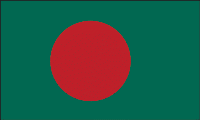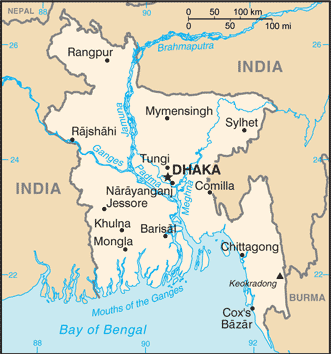Nov 5 2012
Topics Covered
Welcome to Bangladesh
Overview of Resources
Industrial Minerals
Fossil Fuels
Investment
Sources
Welcome to Bangladesh
Bangladesh is located between India and Burma in southeastern Asia. The total area of the country is 143,998 km2, and it has a population of 161,083,804 as of July 2011. The country’s climate is predominantly tropical.
 |
The national flag of Bangladesh.
Image Credit: CIA Factbook |
East Pakistan, which split from India after India’s independence, later seceded from West Pakistan in 1971 and was renamed Bangladesh. The country has struggled with unstable governments and devastating floods over the years, which has rendered it a poor nation. The GDP of Bangladesh was $285.8 billion in 2011.
The natural resources of Bangladesh are limited and include natural gas and coal. Its mining sector does not play a significant role as the country relies more on agriculture and textiles.
Overview of Resources
In 2010, the mineral sector of Bangladesh produced mainly coal, natural gas, petroleum, and granite. The country lacks metallic mineral reserves but make up for that with huge natural gas potential.
The Bangladesh Oil, Gas and Mineral Corp. (Petrobangla) is solely owned by the state. The state is responsible for all exploration, production, and distribution of natural gas.

The national map of Bangladesh. Image Credit: CIA Factbook
Industrial Minerals
There were 34 cement companies operating in Bangladesh in 2010, which collectively produced about 18.5 million Mt of cement. The domestic demand for cement is growing due to the government’s programs to enhance the country’s infrastructure.
The Bangladesh Cement Manufacturers Association stated that in 2010, the country exported nearly 14,000 Mt/month of cement to India. In that year, the Bashundhara Group made plans to open two cement manufacturing plants by early 2012 with an aim to produce about 12,000 Mt/d, which would in turn address the local demand for cement.
In 2010, Maddhapara Granite, a subsidiary of Petrobangla, produced granite at an underground mine in the District of Dinajpur. The mine’s capacity was about 1.65 Mt/yr of hard rock.
Fossil Fuels
In 2010, the Barapukuria coal mine was the only operating coal mine in Bangladesh. It operated by Barapukuria Coal Mining Co. Ltd. (BCMCL) which is a subsidiary of Petrobangla. The mine’s total production was estimated as 857,000 t in 2009.
In 2010, Asia Energy, a subsidiary of Global Coal Management Resources (GCM) of UK, was waiting for a license from the government to develop the Phulbari coal project. Once the company acquires the license, it plans to develop a mine in three years using an open cut mining method to extract coal. Experts state that the Phulbari coal project could probably be the answer to the country’s electricity shortage problem.
Petrobangla was involved with detailed exploration and drilling operations to increase gas reserves in 2010. The proven recoverable gas reserves as of 2009 were about 188.6 billion m3. Bangladesh produced about 20,500 million m3/yr of gas. However, it still faced a shortage of about 4,125 million m3/yr of gas.
Petrobangla accepted the proposal submitted by Chevron Corp. of USA to claim a share for developing gas Block 7 along with GS Caltex of the Republic of Korea. GS Caltex was the first Korean company to conduct hydrocarbon exploration work in Bangladesh.
In 2010, Beximco Group of Bangladesh and Marasel Company Ltd. of Saudi Arabia were keen on funding the expansion project of Eastern Refinery Ltd., which would help increase the refinery’s petroleum production to 4.5 Mt/yr from 1.5 Mt/yr.
Investment
Earlier this year, a group of United Nations independent human rights experts requested the government to not give permission for the open pit mine at the Phulbari coal project, as it would displace thousands of people, destroy nearly 12,000 hectares of productive agricultural land, and ruin the ecosystem. However, according to the latest reports this month, a committee of experts submitted a report approving open pit mining in the Phulbari coal deposit to the energy and mineral resources ministry.
The government of Bangladesh is working towards improving the facilities in the country so as to make the country an attractive destination for investors. To meet the local demand for raw materials to help build the country’s infrastructure, Bangladesh has begun developing partnerships with its neighboring countries. It has also been trying to resolve the maritime boundary disputes with Burma and India.
Once the government plans for improvement are completed, the mining sector of Bangladesh will have a bigger role to play in the country’s economy.
Disclaimer: The Author of this article does not imply any investment recommendation and some content is speculative in nature. The Author is not affiliated in any way with any companies mentioned and all statistical information is publically available.
Sources
http://minerals.usgs.gov/minerals/pubs/country/2010/myb3-2010-bg.pdf
https://www.cia.gov/the-world-factbook/countries/bangladesh/
http://www.un.org/apps/news/story.asp?NewsID=41398#.UIUk88VZXik